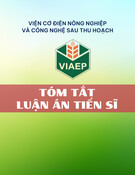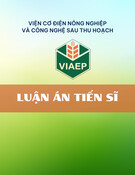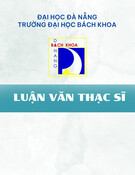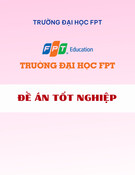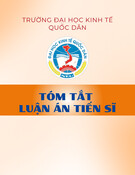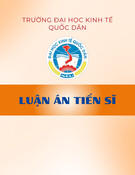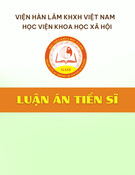MINISTRY OF EDUCATION AND TRAINING
CAN THO UNIVERSITY
SUMMARY OF PhD THESIS
Major in Rural Development
Code: 62620116
PHAM NGOC NHAN
SOLUTION TO IMPROVE THE EFFICIENCY OF FARMING MODEL CONVERSION ON RICE LAND IN HAU GIANG PROVINCE
Can Tho, 2021
i
LIST OF PUBLICATIONS OF AUTHOR RALATED TO THE STUDY
of Agriculture
Journal
Pham Ngoc Nhan, 2018. Comparison of finacial efficiency of models two rice crops – one upland crop with 3 rice crops at Hau Giang province in 2017. Science and Technology and Rural Development, 12 (2018): 99-105. ISSN: 1859-4581.
Nhan Pham Ngoc, Liem Le Tran Thanh and Trang Kieu Pham, 2018. Research on factors affecting the conversion of crop compositon on rice land in Hau Giang provice – Viet Nam. Journal of International Scientific Publications: Agriculture & Food, 6: 325-330. ISSN: 1314-8591.
Nhan Pham Ngoc, Be Tran Thanh, Liem Le Tran Thanh, and Trang Kieu Pham, 2018. Identifying factors affecting farmers’ adoption of cropping pattern conversion to two rice crops – one cash crop in Vi Tan commune, Hau Giang province. Journal of Viet Nam Agricultural Science and Technology, 1(3): 68-73. ISSN: 0866-8116.
and
frequency
several
on
Nhan Pham Ngoc, Tin Huynh Quang, Huy Le Duc and Liem Le Tran Thanh, 2019. Impacts of watering biophysics method characteristics and productivity of waxy maize (Zea mays L.). Journal of International Scientific Publications: Agriculture & Food, 7: 297-308. ISSN: 1314-8591.
ii
THIS RESEARCH WAS COMPLETED
AT CAN THO UNIVERSITY
Scientific Main Supervision: PGS.TS. Huỳnh Quang Tín
Scientific Secondary Supervision: TS. Trần Thanh Bé
The thesis will be defended against the council state thesis meeting
At: Thesis defense room, Can Tho University.
At 14 h 00, 25/11/2021
Reviewer 1: PGS.TS. Duong Ngoc Thanh
Reviewer 2: TS. Tran Thi Ngoc Son
This thesis can be found at:
Learning Resource Center, Can Tho University
National Library of Vietnam
iii
CHAPTER 1 INTRODUCTION
1.1 THE NECESSARY OF RESEARCH
to
In particular, agricultural production in the Mekong Delta in general and Hau Giang province still focuses on intensive rice cultivation to increase yields to meet food security requirements and serve export. However, the intensification of crop intensification and the expansion of paddy land negatively impacted the ecological environment, manageable economic risk, and negative impacts on farmers' social lives. In terms of climate and health, rice monoculture was also the cause of the increase in pests, diseases, and soil degradation. This will affect the biodiversity of agricultural species. Economically, due to monoculture in rice production, price fluctuations in the market (inputs and outputs of production) would made incounstablemers farmers' income more, impacts of extreme weather, natural disasters, climate change and pest outbreaks will reduce rice yields and affect rice farmers' profits. Socially, due the changing environment and unstable profitability of rice growers, it would directly or indirectly affect producing households' livelihoods and depend on agriculture. In the current conditions of fragmented agricultural land
1
and low arable land/household, if farmers monoculture rice, they would be limited other household production activities such as livestock farming, aquaculture, crops, and non-agricultural activities.
efficiency to
It stemed from the policies and orientations of the Goverment in restructuring the agricultural sector. restructuring of crops and diversifying The agricultural activities on rice land was considered a key solution in Restructuring crops in the Mekong Delta's rice-intensive regions. In addition, crop in Hau Giang province was vital, conversion contributing and production sustainability of farming in the province. Since then, it was necessary to have specific studies pointing out the conversion models on rice land to bring high income; the conversion factors were required.
From the above theoretical basis, the topic Solutions to improve the farming model's efficiency on rice land in Hau Giang province was implemented. The thesis's research results will show effective farming models on rice land, promoting a healthy transition during the agricultural sector's restructuring period, contributing to concretizing Agricultural, Farmers and Rural policies of Government.
2
1.2 THE OBJECTIVES OF THIS STUDY
1.2.1 Overall objectives
Research on solutions to improve the efficiency of changing the efficiency of farming models on rice land to improve farm household income, contributing to the implementation of the agricultural sector's restructuring orientation in association with the model of sustainable agricultural development in Hau Giang province.
1.2.2 Detail objective
To have a basis to achieve the overall goal, the research content of the thesis will, in turn, implement the following specific objectives:
Objective 1: Evaluate the current status of crop conversion on farmers' rice land in Hau Giang province.
Objective 2: Analyzing resources of farmers in
the process of production change on rice land.
Objective 3: Analyze the factors affecting the
farmers' decision to convert crops on rice land.
Objective 4: Propose solutions to improve the efficiency of changing rice cultivation models for farmers in the province.
3
1.3 THE NEW FINDING OF THE STUDY
the
technical transfer
The thesis's research was studied the scientific basis of transforming the useful farming model on rice land, including the status of inefficient 3-crop rice cultivation that needs to be converted to a subtable farming model. The thesis was also built a theoretical basis for changing the farming model based on the socio-economic situation, the farm household's resources, and the impact of internal and external factors. The study identified groups of factors that impact transformation of farming models, including the effects of climate change, government training, market policy, FFS integration, and potential farmer's force. Besides, the dissertation was given the views, orientations, and solutions to improve the efficiency of farming model conversion by evaluating model financial indicators.
4
CHAPTER 2 LITERATURE REVIEW
2.1 OVERVIEW OF COOPERATION
SYSTEM, CONVERSION COOPERATION
SYSTEM
2.1.1 Cultivation system
farm resources
A farming system is a combination of specific combinations of in a given environment by technological methods that produce primary agricultural products. This definition does not include processing activities that often go beyond the standard form of farming for specific livestock and crop products (IRRI, 1989, cited by Le Thi Nghe et al., 2006).
2.1.2 Changing the farming system
transformation occurs to reduce
Changing the farming system is one of the main contents of the agricultural economics restructuring, the rural economy in general. In agriculture, the economic structure has shifted towards reducing crop production and moving to livestock production, fisheries, and agricultural services. In farming, the the structural production rate of food crops, gradually turning to the
5
production of food crops, short and long-term industries, and fruit trees.
2.1.3 The concept of agricultural
restructuring
- Concept of plant structure
Crop structure is the proportion of crops grown in an area at a given time. Crop structure is closely related to the agricultural sector structure; it reflects the internal division of labor in the agricultural sector by the natural, socio-economic conditions of each region (Pham Chi Thanh, 1996).
- Concept of crop conversion on rice land
Changing crops on rice land can be understood as the arrangement of time and space-based on rice farming practices and crops and livestock products such as shrimp, fish, produce, and rotation with rice for production more effectively. In terms of time, the arrangement of seasons is reasonable with weather, climate, irrigation water conditions, and space is suitable for each ecological region, the ratio of the area to each season.
To convert crops on rice land to bring high economic value, improve land-use efficiency, ensure appropriate farming techniques, intensive farming,
6
and increase farmers' income. In this study's scope, the conversion model's efficiency was focused on the research on the profitability of each group of crops converted on rice land and showing which model brings higher profit value compared to planting rice in the same crop.
CHAPTER 3
METHODDOLOGY
3.1 APPROACH METHOD
To study solutions to improve the efficiency of changing the rice cultivation model required a deep understanding of rice production issues; rice farming models were applied by farmers used effectively in the past. In the research scope, the systematic approach and the participatory assessment method were used throughout the thesis's data collection.
3.2 ANNALYSIS FRAMEWORK
improving production
the agricultural sector, especially
Based on the theoretical and practical analysis, with the research approach selected, the thesis focused on efficiency associated with sustainable values and adapting to the current context. Changing crops on rice land was a trend of in inefficient 3-crop rice areas. The crop conversion was
7
carried out in an unstable agricultural market and the impact of climate change with lack of fresh water and saline intrusion on rice cultivation land.
Hau Giang province was selected as the study area. The research object was the production model on rice land to analyze the current situation and change trends in the locality to raise the study's overall problem. Next, rice farmers were surveyed, with assumptions that include external factors (local production market, weather/climate policy, conditions). Internal resources (financial resources, labor resources, production techniques) impact the farmers' transition of crops on rice land.
From these resource analysis results,
the technology transfer model through the FFS course had been implemented by local extension workers to improve internal resources regarding new crop production techniques in rice land for farmers. And conduct field trials to demonstrate the transformation model's effectiveness to help farmers boldly change their production model, aiming to improve farmers' production efficiency, contributing to adapting to the current context.
From the results of the farmer's transformation, the research went into depth analyzing the factors
8
the
affecting the model's transition, showing effectiveness and the transformation direction of the farmer. Following, the thesis offers solutions and lessons for the locality.
3.3 METHOD OF RESEARCH AREA AND
SAMPLE SELECTION METHOD
3.3.1 Method of research area
To have information on the implementation of the thesis, the representative points in Hau Giang province were selected to collect data, including representatives of low-lying, alluvial, inundated areas in Truong Long A commune, Chau Thanh A district; representatives of alum contaminated soil in Hoa An commune, Phung Hiep district; representative of the area affected by saline intrusion in Vi Tan commune, Vi Thanh city.
3.3.2 Method of sample selection
To collect information for in-depth survey, rice- producing households were selected for the study in this study. Household size was selected with a sample size of 270 production households representing three research points. The sampling method was convenient to combine stratification.
9
3.4 METHOD OF DATA ANALYSIS
Objective 1: Using descriptive and comparative statistical methods; Testing differences; Analyzing the model's financial indicators used to assess rice production's current state and transform the farming model; Describing general characteristics of rice- producing households.
Objective 2: Farmers'
resources collected through the interview questionnaire include: human capital, natural capital, physical capital, financial capital, social capital. The technical pilot of upland crops in the field: Technical test of growing water- saving corn in rice fields in Truong Long A commune, Chau Thanh A district, Hau Giang province to find out the technical process of cultivation, saving water for upland crops in the Summer-Autumn yield for land with water inactivity in Hau Giang province.
Objective 3: Analyze based on Exploratory
Factor Analysis (EFA) method.
Objective 4: Using
analytical methods synthesizing the results of the situation assessment (Objective 1), the effects of technology transfer and the selection of experimental models (Objective 2), the impact factors to the transformation model (Objective 3) to propose solutions and effective 10
to promote
farming models for each ecological region. In addition, the study also recommended appropriate policies transition: production the planning, human resources, resources, science and technology, plant varieties, livestock, irrigation, the ability to link the market for converted products.
CHAPTER 4 RESULTS AND DISCUSIONS
4.1 CURRENT SITUATION OF PLANT
CONVERSION ON RICE LAND IN HA GIA
GIANG PROVINCE
4.1.1 Timeline of the farmer's
transformation
Survey results on the timeline of changing farming model on farmers' rice land in Figure 4.1 showed that the conversion household in the last five years had the highest rate (48.9%). Households converting over 5 to 10 years account for 24.4%. Households converting over 10 years was accounted for 26.7%.
11
26.7%
48.9%
24.4%
Under 5 years
From 5 to 10 years
Over 10 years
Timeline of the farmer's
transformation
Resource: Results of a survey of 90 households with transformed models in 2017
4.1.2 The proportion of land converted to
crops by farmers
Survey results on rice land's rate converted to cropland showed that the highest percentage for households with a converted land area was over 75% (71.1%). Next was the group of households that recycle from 50 to 75% (18.9%). The largest group was households with a conversion rate below 25% (4.4%).
4.1.3 The crop group was converted by the
farmer on the rice land
Survey of crops converted on rice land in Hau Giang province showed that there are 4 main crop groups, including Group 1 grows crops of vegetables
12
as leaf vegetables such as mustard greens, lettuce, and spinach (accounting for 28.9%); Group 2 includes farmers growing corn (accounting for 35.6%); Group 3 includes farmers who grow melon, watermelon (21.1%) and Group 4 includes households who grow lianas for fruits such as gourd, squash, bitter melon (14.4%). The crop group was converted by the farmer on the rice land.
14.4%
28.9%
21.1%
35.6%
Group 1 Group 2
Group 3 Group 4
The crop group was converted
Resource: Results of a survey of 90 households with
transformed models in 2017
4.1.4 Costs and benefits of crop groups are
converted on rice land
The results of cost and profit analysis of the four crop groups cultivated on rice land were showed in Table 4.1. For the group of households growing watermelon, melon had the highest investment cost
13
(41.6 million VND/ha/crop) and the relatively high- profit household group (46.8 million VND/ha/crop). The group of crops with lower investment cost was growing leafy vegetables with 39.9 million VND/ha/crop, but the group with the highest profit (49.7 million VND/year/crop). The group with the lowest investment cost and profit among the four groups of crops was the group that grows corn, at 21.2 million VND/ha/crop and 21.0 million VND/ha/crop, respectively. Growing vines to get fruit had an investment cost of 25.2 million VND/ha/crop and a profit of 37.4 million VND/ha/crop.
Unit: Million VND/ha/crop
Group
Costs Benefits
Profit Margin
39,9
49,7
1,25
Leaf vegetables
21,2
21,0
Corn
0,99
41,6
46,8
1,13
Grow melon, watermelon
25,2
37,4
1,48
lianas Grow for fruits
Resource: Results of a survey of 90 households with transformed models in 2017
14
From the above study results, analysis of variance ANOVA showed a statistically significant difference of 5% for investment costs and profitability of the four crops cultivated on rice land. Sig. coefficient of investment cost was 0.021 <0.05 and Sig. coefficient. The profit from growing crops was 0,000 <0.05.
4.1.5 The reason for changing crops on rice
land of farmers
that
The farmer survey results on the reasons for the rice cultivation model's conversion showed the profitability of the cropping pattern on rice land was an essential factor affecting the household conversion. In this study's scope, the factor of profit was highly appreciated by farmers and considered it the top criterion of the model transformation, accounting for 57.3%. This was one of the factors interested in analyzing the effectiveness and impacted on the conversion model in the following content.
Next was the farmers who follow their neighbors. They thought that the neighbors cultivate the crops effectively, so they learned to tail (17.4%). The survey results in Figure 4.3 also showed that the impact of diseases caused by three rice crops a year was also a factor that causes farmers to change their farming model, but this factor only accounts for 14% in transition. Besides,
15
weather factors also impact the farm household's transformation, but it accounted for a low rate (10%).
Hight Profit
57.3
Pollicies of Government
1.3
Imitate the neighbors
17.4
Disease
14.0
Climate change
10.0
0
20
40
60
% 80
The reason for changing crops
on rice land of farmers
Resource: Results of a survey of 90 households with transformed models in 2017
4.2 RESOURCES OF FARMERS IN RICE
PRODUCTION MODEL CONVERSION
4.2.1 The cultivated land area of the farm
household
Through the survey, the number of households owning rice cultivated land less than 0.5 ha accounts for the highest proportion (44.8%), followed by the group of households with rice cultivated land area from 0.5 to 1.0 ha, accounting for 31.9%, and the
16
number of households with arable land per hectare was the lowest, 23.3%. Similarly, for households with land area under rice crops under 0.5 hectares, accounting for the highest proportion (accounting for 69.3%), the lowest group of households with land area more than 1 ha accounting for 5%.
4.2.2 Number of laborers in the household
Group
Vi Thanh
Chau Thanh A
Phung Hiep
Under 3
6.1
7.2
7.8
From 3 to 5
20.6
16.7
18.9
Over 5
6.7
9.4
6.7
Resource: Results of a survey of 180 households in 2017
The analysis of the number of workers in the household showed that farmers with labor resources from 3 to 5 people/household account for the highest percentage. Chau Thanh A district accounts for the highest rate in this group of workers (20.6%). For the workers under three people/household, Chau Thanh A district accounts for the lowest percentage (6.1%). The results of group discussions with farmers showed that the farm household's current labor force is sufficient for the conversion model of smallholder
17
farmers. However, it is necessary to hire labor with a large conversion area, especially in the harvest season. Analysis results also showed no statistically significant difference between the study areas (Sig. = there was no 0.648> 0.05). Simultaneously, statistically significant difference when comparing labor resources between the group of farm households that converted and did not change the model on rice land (Sig. = 0.220> 0.05)
4.2.3 Financial resources in agricultural
production of farmers
The analysis results of capital in farmers' production in Table 4.3 showed that farmers' money with the model switch was higher than the non- converting households (45.2 million VND / year). For loans, loans mainly come from the Bank for Agriculture and Rural Development and the Bank of Social Policy. Besides, farmers still borrow capital from other sources such as loans from relatives, neighbors, or local mass organizations.
18
1. Loan
Transformed model (Million VND)
Interest Rate (%)
Non- transformed model (Million VND)
65,2
62,4
6,5
Agribank and Social Policy bank
15,1
21,0
8,0
Loan from relatives
2,6
0
0
Loan from neighbors
30,4
0
9,6
Loan from credit institutions
21,7
23,6
8,5
Loan from all-union
5,0
0
8,5
43,8
45,2
Loan from others 2. Self- owned family capital/year
Resource: Results of a survey of 180 households in 2017
19
4.2.4 The impact of FFS
technology transfer training on farmers' transformation
trends
In the research scope of the topic, through the training course on converting rice production models to increase internal resources for farmers. This training course was seen as a tool to increase farmers' inner strength by providing new product knowledge and techniques relevant to changing and adapting to the context of climate change the current.
4.2.5 The impact of the training on the
capacity of farmers
Assessing the impact of the FFS training on farmers' capacity shown in Figure 4.4 showed that farmers could confidently apply scientific and technological advances in their fields, accounting for the highest proportion (32.2 %), next was to improve farmers' capacity in field management, disease prevention at 26.4%. The ability to link with the market to consume and seek output for products had not been effectively promoted by farmers, accounting for the lowest percentage (1.3%).
4.2.6 The farming models are applied on
rice land in farmers after the training
20
After one year of participating in the training course to transfer technology, the farmers changed the rice land cultivation model with a shallow rate (3.3%). The majority of models convert on small areas of land with crop models testing crops on rice soils. The percentage of farmers who did not change their farming model accounts for 96.7%. This result also reflected the reality in the study area. However, farmers were technologically knowledgeable after being trained. For them to apply directly in the field, there were many influencing factors such as capital, market agricultural product schools, irrigation conditions, and preferential policies upon conversion.
4.2.7 The experiment of water-saving
irrigation techniques for maize has been
converted in the summer-autumn rice crop
The pilot of the effect of irrigation method and irrigation cycle on the growth and yield of sticky corn variety roosting on rice land at a farmer household in Truong Long A commune, Chau Thanh A district to find a water-saving irrigation technique that is suitable for drought conditions in the Summer- Autumn crop in the region. Glutinous corn is a maize group that is being consumed intensely in the market
21
in Chau Thanh A district and has a farming time suitable for a rice crop of farmers.
4.2.8 Results of some indicators collected in
the pilot
treatments at
- Corn weight at harvest: Analysis results showed that treatment A1B2 had the highest average corn weight (195.6 g), followed by treatment A1B1 (193.0 g), and the lowest was treatment formula A1B3 (164.7 g). For treatments with the watering cycle of 5 days/time, the average weight/maize was lower than the watering cycle one day/time and three days/time. Analysis results showed a difference in the irrigation cycle between experimental the significance level α = 0.05 (Sig. = 0.006).
- Weight of 1000 seeds: Analysis results showed that the harvest weight of 1000 seeds was highest in treatment A1B2 (395,2g), followed by treatment A2B2 (395,0g), and the lowest was treatment A1B3 (383.6g). The weight of 1000 seeds after drying to 14% moisture (by the storage moisture) showed that treatment A2B2 had the highest weight of 1000 grains (148.6g), followed by A1B1 (142.9g), A1B2 had a weight of 142.3 g, and the lowest was treatment A1B3 (133.5 g).
22
- Theoretical yield: The results of analyzing the theoretical yield of the treatments showed that treatment A1B2 had the highest theoretical yield (66.8 quintal/ha), followed by treatment A1B3 (61.4 quintals/ha), and the lowest was in treatment A2B3 (56.1 quintal/ha). Initial research results showed that the treatments using the sprinkler method have higher yields than the treatments using the nasal irrigation method. For the irrigation cycle on maize, it was found that all treatments watered every three days, watered once for the highest yield.
- Actual yield: Analysis results showed that the actual yield of treatment A1B2 was the highest (65.5 quintal/ha), the lowest was in treatment A2B1 (49.1 quintal/ha). Research results showed that when supplying too much water to the plant or too little water makes the plants unable to promote their full growth capacity, reducing corn productivity.
- Accounting of maize growing models in rice
fields
To had a basis for the real calculation of the financial ratios of the corn-on-field model. The trial of planting corn with a scale of 1000 square meters of land applied the technique of sprinkling irrigation combined with three days of watering/time at the time
23
of the Summer-Autumn crop of 2019 (after one year of experimenting to find the appropriate irrigation technique) was carried out and evaluation of financial ratios on Table 4.5.
STT
Indicator
Money (Million VND/ha)
Corn Rice in Summer- Autumn crop
Investment
24,390,000
18,100,000
1
2
Income
43,700,000
27,000,000
3 Profit
20,020,000
8,900,000
4 Rate of
0.82
0.49
Profit/Investment
Note: Results analyzed based on farmer's field pilot in 2019
The model's cost analysis results showed that the investment cost in the corn production model is 24,390,000 VND / ha, the profit of the model is 20,020,000 VND / ha. The rate of return of the model was 0.82, which means that the farmer who invests 1 VND will profit from 0.82 VND. Compared with the Summer-Autumn rice crop, the model of planting corn to replace the Summer-Autumn crop has 2.25 times higher profit.
24
4.3 ANALYSIS OF FACTORS AFFECTING THE AGRICULTURAL COMMUNITY MODEL
CONVERSION ACCEPTANCE
- Describe the variables included in the analysis
model
Desciption of the scale
Components of the scale
Sign of the scale
Q1
Knowledge gained from an FFS course influences acceptability
Q2
of influence The technical factors from the course
F1: The FFS training course's impact
Possibility to strengthen linkages among farmers
Q3
after FFS
Q4
An efficient conversion model was approached from the FFS course
Q5
Farmers' education
25
Desciption of the scale
Components of the scale
Sign of the scale
resources of
Q6
Financial farmers
F2: Personal capacity of farmers
resources
of
Q7
Labor households
Q8
The conversion model would be supported by concessional loans
Q9
assistance to the
changing
Technical would be provided farmers model
had
locality
Q10
F3: Government policies
a The transformation planning policy
link
Q11
The locality had a policy to product consumption for farmers
Q12
suitable
The locality invests in systems, irrigation for ditches farming models
26
Desciption of the scale
Components of the scale
Sign of the scale
Q13
The conversion model brought high economic efficiency
Q14
The product had a higher selling price
F4: Market price and linking scale
Q15
Products were easy to link production/consumption of products with the company
Q16
The current weather was farming for suitable patterns
Q17
Irrigation water was guaranteed all year round
F5: Climate change/land/water
Q18
resources
Irrigation water was saline by affected intrusion
to
Q19
Climate change causes rice damage monoculture should be converted
27
Desciption of the scale
Components of the scale
Sign of the scale
Q20
The land was no longer suitable for 3-crop rice
Q21
Feel the benefits of adopting a conversion model
Y: The degree of
conversion
former the
Q22
acceptance of
Accumulated in production convertible model
farmers
Q23
Introduce the models to surrounding farmers
- Explain the variables in the research model
The proposed theoretical model includes five
components:
1. Scale components The FFS training course's impact reaches Cronbach's alpha coefficient with a value of 0.928.
2. Ingredients Personal capacity of farmers was
Cronbach's alpha coefficient reaching 0.630.
3. Scale components Goverment policies were
Cronbach's Alpha coefficient reaching 0.823.
28
4. Market price composition scale
and association with Cronbach's alpha coefficient reaching 0.893.
5. Components of Climate change/land/water resources impacted Cronbach's alpha coefficient reaches 0.722.
The scale of farmer acceptance is the dependent component. The remaining five components are independent and are assumed to affect the level of acceptance of farmers with the model. The theory is as follows: Y = a + a1 F1 + a2F2 + a3F3 + a4F4 + a5F5
Variable Y: Level of conversion acceptance, F1: Impact of FFS courses, F2: Personal capabilities, F3: Government policies, F4: Market prices and integration, F5: Impacts of climate change/land/water resources.
The variable depending on the degree of conversion acceptance of farmers was formed from 3 variables Q21, Q22, Q23 of the scale. The dependent variable's value was the factor score calculated by SPSS software through factor analysis, a linear combination of the variables Q21, Q22, and Q23 and has been standardized.
29
Likewise, the value of the independent variables Factor score is also calculated by SPSS software through factor analysis, including:
1. Independent variables: The FFS course's impact was made up of 4 variable Q1, Q2, Q3, and Q4.
2. Independent variables Personal capacity was
formed from 3 variables Q5, Q6, and Q7.
3. Independent variables Government policies were made up of 5 variables Q8, Q9, Q10, Q11, and Q12.
4. Independent variable Price/market and link
were formed from 5 variables Q13, Q14, and Q15.
5. Independent variables Impacts of climate change/land/water resources were formed from 4 variables Q17, Q18, Q19, and Q20.
the
The values of the independent variable and the dependent variable are both normalized. The expected sign in the relationship between the independent variable and the dependent variable was a positive sign. When independent variable's value increases, the value of the dependent variable will increase in this research model. The study continued to do a regression analysis to determine each
30
component's weight affecting the degree of farmers' acceptability of changing rice land farming patterns.
- Correlation between variables in the model
indicates to 0.916, which
The regression analysis results showed that the R-value was 0.957, indicating that the relationship between the model variables had a very close correlation. Reporting the regression results of the model showed that the value of R2 (R Square) was equal the model's appropriateness was 91.6% or, in other words, 91.6% of the variation of the level. Five scale components explained the farmer's acceptability to change the farming model on rice land. The adjusted R2 value (Adjusted R Square) more accurately reflects the model's suitability to the whole. The adjusted R2 value equal to 0.913 (or 91.3%) means a linear regression model calculated between the Conversion Level and the five impact scale components.
Results of ANOVA variance analysis showed that F-value had a significant level Sig. = 0.000 (<0.05), which meaned that the regression model was consistent with the collected data and the variables included were statistically significant with the 5% significance level. The statistic value of F = 366,949 was used to test the hypothesis H0, and the analysis
31
results showed that the linear relationship was very significant with p_Values <0.05. From the above results, the study could reject the hypothesis H0 that the slope of 5 scale components was zero. Thus, the independent variables in the model were related to the dependent variable change.
in
The regression coefficients analysis in the model showed that the significance of the component of the Government Policies scale (F3) and the Market price scale and association (F4) was valid less than 0.05. The remaining scale componented include F1: Impact of FFS training, F2: Personal capacity, F5: the value of climate change impacts was more significant than 0.05. Thus, the study could conclude that two independent variables F3 and F4 impact farmers' acceptability of changing rice cultivation models. These two impact components were significant in the model. They positively impacted the degree of farmers' acceptance of the change of farming model, which was explained by the signs of the regression coefficients. The independent variables' standard regression values the valid model were Government policies: 0,501; Price/market and association: 0.466.
32
From the results of regression analysis, the
model was written as follows:
Y = 0.002 + 0,501F3 + 0.466F4
• Y is the degree of acceptance of conversion by
In which:
• F3 is an element of Government policies.
• F4 is the market price and the producer
farmers.
association.
The above model explained 91.3% of the variable Y variation due to 2 independent variables in the model. The remaining 8.7% of the variation is explained by other variables outside the micro topic model can not be studied.
independent variables were
The regression equation explained that, if the kept remaining unchanged when the Government policies increase by 1 level, the Farmers' acceptance of conversion increases on average to 0,501, when evaluating market price and association increased by 1 degree, farmer conversion acceptance increased by 0.466 level. Through regression analysis, results showed the importance of each independent variable for the dependent variable.
33
The B-value showed that the standard regression of Government policies affect 50.1% of farmers' conversion acceptability, the standard regression of Market Price and the link affects 46.6%. The results also showed that the more valuable the component, the more it affects the level of conversion acceptance, specifically: Farmers' acceptance of conversion is most influenced by the State Policy component and locality (Beta = 0.55), the second most important component is the Market price and the association (Beta = 0.469).
4.4 PROPOSING SOLUTIONS TO
IMPROVE EFFICIENCY CONVERSION
CONVERSION ON RICE LAND
4.4.1 For the provincial policies
- In order to convert effectively to farmers, the local government needs to do detailed planning for each type of tree, each region, and according to the production season. To focus on commodity-oriented production, linking the processing and sale of products.
- Regarding the policy solutions to support the transformation, the local government at the provincial level needs to perfect policies that directly affect
34
to overcome bottlenecks,
farmers' production to motivate people to participate in the crop conversion process in inefficient rice land. Specifically, the policy of supporting convertible capital needs to be overcome by the provincial remove government difficulties such as rescheduling debt repayment terms, interest rate subsidies, exemption or reduction of loan interests, and promote the development of industries declaration to the people, disbursement of capital is at the rate of the provincial conversion project.
- Regarding solutions to organizing production, local authorities need to issue appropriate and comfortable mechanisms and policies for farmers to access restructuring crops on inefficient rice land. Promote agricultural extension policies, perfect projects to support producers directly. Thereby, farmers have information and choose the right products to convert. Although the Science and Technology Transfer Course for Farmers (FFS) research results were not highly effective, the communication solution on application models on rice land for farmers also needs to be organized in a manner more suitable for people to easily access scientific and technical advances.
35
impact
- It is necessary to improve policies that farm households' conversion indirectly efficiency, such as land policies, infrastructure development policies, science and technology policies, to promote agricultural actors' participation in transition. In particular, it is necessary to have policies allowing people to use rice land flexibly from changing their approach to thinking about food security only depending on rice plants.
4.4.2 For linking production and product
market
region. From
farmers. To seek
- The changing mode of agricultural production of farm households through cooperative groups produces and consumes a type of agrarian product there, creating a converted by synchronous association in production, aiming to step by step eliminate the small and fragmented traditional the farming practices of concentrated agricultural product farming areas of the farmer groups, to bring into play the strengths of each region's products. This will be a pivotal solution to shift from traditional agricultural thinking to a modern agricultural economy; production needs to be linked to the market to stabilize product output.
36
4.4.3 For training cources
- Although the research results showed that the technology transfer course was not brought conversion efficiency for farmers. However, for agricultural extension, the course was also contributed significantly to the provision of scientific and farmers' awareness. technical knowledge and Therefore, the agricultural extension sector will continue to organize training courses to transfer science and technology with a more appropriate approach.
4.4.4 For tecnology solutions
- Encourage farmers to apply water-saving irrigation techniques for converted crops to adapt to the increasingly scarce freshwater resources and extreme weather conditions.
4.4.5 For scientists
- It will be necessary to research and transfer technical advances, put into production suitable varieties, and select short-term plants suited to the season replacement or conversion service. To step up research, application, and replication of new high- yield, good-quality plant varieties resistant to pests and diseases to promptly supplement the crop rotation
37
structure to achieve the highest economic efficiency for farmers.
CHAPTER 5 CONCLUSION AND SUGGESTION
5.1 CONCLUSION
The thesis's research results showed that the situation of the change of production model on rice land of farmers in Hau Giang province is still fragmented and small. The crop groups converted by farmers on diverse rice land include leaf vegetables, corn, melons, watermelon, and fruit vines. For the crop group altered on rice land, including watermelon, melon has the highest investment cost. It is also the crop group with the highest profit among the four crop groups chosen by farmers to convert.
Farmers were labor resources to meet the needs of production conversion in small farming areas. Farmers participating in technology transfer courses were aware of and appreciate the transfer model. However, farmers were not boldly applied the converted production models after the training. The results showed that focusing on technology transfer through FFS training was not the critical solution to the transition.
38
The experimental results showed the spray irrigation method combined with the 3-day irrigation cycle/time for the highest corn yield. This water- saving irrigation technique could be applied to the Summer-Autumn crop to improve the efficiency of maize conversion on rice land in some weak rice- growing areas.
The linear regression analysis results were shown that the factors of Government policies, price/market factors, and the associated impact the farming model's acceptance of farmers' farming model. In which weak Government policies were the highest level of influence.
The solution to improve farmers' conversion efficiency was focused on proposing to have the policy to link production households to convert into raw material areas and connect with businesses to consume output products.
5.2 SUGGESTION
The FFS course is a tool to help the extension industry transfer scientific and technical advances to farmers. However, to evaluate farmers' conversion efficiency from FFS, it will be necessary to continue the research for a more extended period instead of a year as research in the thesis.
39
The ineffective rice land conversion model is not only for a single crop but also for a variety of upland crops and on a group of aquatic and fruit crops. It will be necessary to study suitable farming techniques on rice land to promote the transformation of different farming models to diversify products, distribute crop structure appropriately, and suit each ecological region's characteristics.

